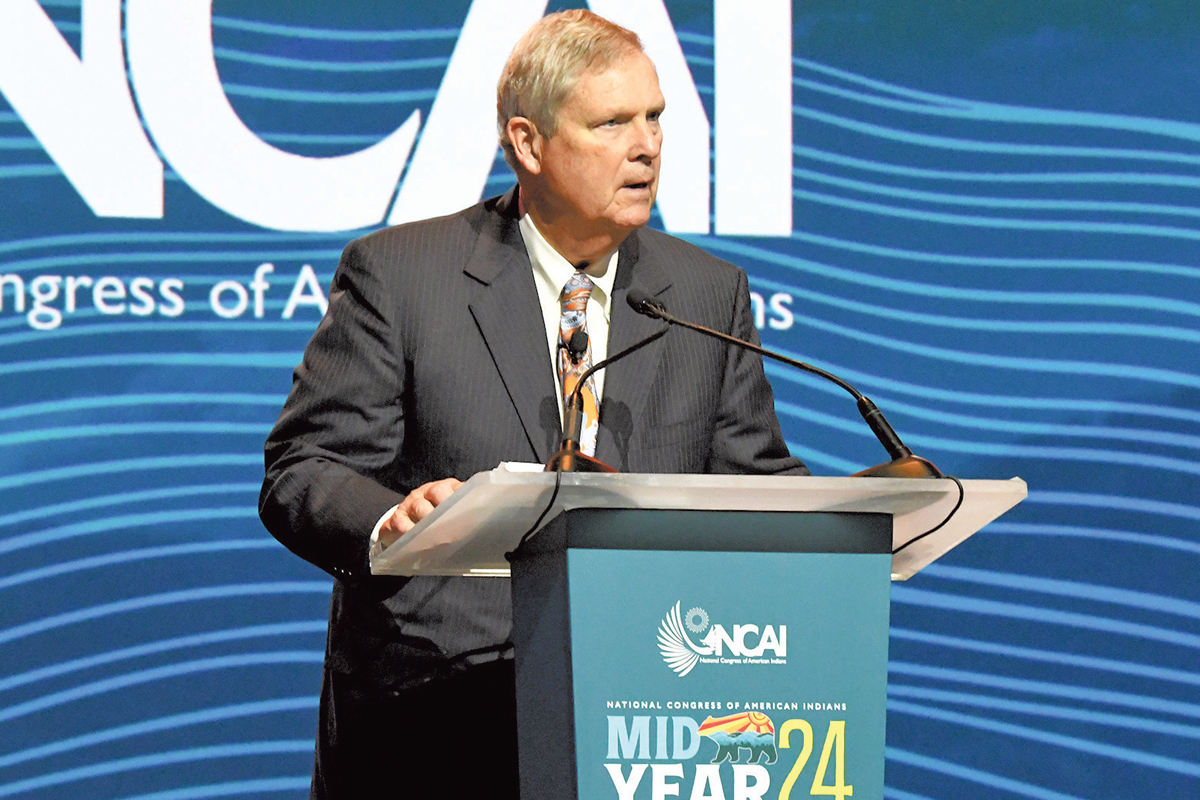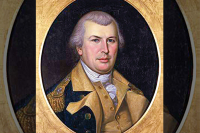U.S. Secretary of Agriculture visits Cherokee
 Vilsack offered remarks to a large crowd of NCAI members at Harrah’s Cherokee Casino’s exhibition center. NCAI photo
Vilsack offered remarks to a large crowd of NCAI members at Harrah’s Cherokee Casino’s exhibition center. NCAI photo
Last week, the Eastern Band of Cherokee Indians welcomed Secretary of Agriculture Tom Vilsack to the exhibit hall at Harrah’s Cherokee Casino to speak to a delegation of members from tribes across the United States as part of the National Conference of American Indians mid-year retreat.
According to its website, the NCAI, founded in 1944, serves as the “unified voice for American Indian and Alaska Native issues.” The nonprofit advocates for policies and initiatives at all levels that are driven by consensus of the organization’s diverse membership. Last week’s event in Cherokee not only provided training and welcomed various speakers, it was also a chance to vote on the future direction of the organization.
Serving under President Joe Biden as Secretary of Agriculture is actually Vilsack’s second go-round in that position as he’d previously served in that role in President Barack Obama’s cabinet. Prior to that, he served two terms as governor of Iowa.
First Vilsack offered some brief remarks, during which he expressed gratitude for being able to speak, the new members of the USDA Tribal Advisory Committee and also Cherokee for hosting the conference. He used the speech to emphasize the value he places on that committee.
“In that capacity, I look forward to the opportunity to get to receive from them additional guidance and help, as we work through the multitude of issues that are important to Indian country,” he said, also specifically mentioning how vital Heather Dawn Thompson, Director of the Office of Tribal Relations has been in that mission.
Vilsack said that Thompson, whom he mentioned several times throughout his time onstage, and her team put together a progress report that he had with him which will guide USDA policy as it applies to tribes, which he acknowledged have vastly different cultures, priorities and issues.
Related Items
“She suggested that we needed to better integrate indigenous knowledge into the activities of USDA, and to understand and then also to incorporate tribal values, as we not only address tribal priorities, but also the priorities generally, of USDA,” he said. “And finally, she suggested the need for us over time, to support more fully and transparently the notion of tribal self-determination.”

Along with speaking, Vilsack took questions from audience members as NCAI President Mark Macarro moderated. NCAI photo
Such a recognition of self-determination and a respect of sovereignty framed the rest of Vilsack’s remarks to the eager crowd of hundreds, from various tribes across the country, who listened intently as the secretary delivered his remarks and answered questions. Vilsack noted that while there’s still plenty of work to be done in that area, he also claimed that his office has taken some significant strides.
“I’ll give you one example,” he said. “There are some tribes that work through corporations and institutions that don’t quite fit a statutory definition within our world and other programs, have a donor team went to work and worked with our rural development officials to basically suggest that perhaps there was a way in which we could work around that barrier. So that a program like the community facilities program, which provides grants and loans for a wide array of opportunities, from childcare centers, to hospitals, to schools, to community centers, and the leg could essentially be made more readily available. That barrier was taken down.”
However, to make further strides, Vilsack said that the USDA needs to have a concrete understanding of the over 200 treaties the United States has with different tribes in areas where the USDA has land.
A big theme for the day was food sovereignty, something that Vilsack explained by using examples that highlighted tribes from different regions. For example, the USDA establishes certain standards for school lunches, including a requirement for whole grain foods. However, some tribes traditionally don’t eat whole grains and rather eat starchy vegetables, something he said should be acknowledged and accommodated. One of the USDA’s chief priorities in the last few years has been ramping up the country’s meat processing capacity. When it comes to some tribes, this may include fish or buffalo meat, which are not only vital as food products for members of those tribes but also the tribal economy.
To those ends, Vilsack announced a few new USDA initiatives that will be backed with considerable funding, including $42.5 million for meat processing.
But along with touting what Vilsack and some in the crowd may have considered victories, he also highlighted challenges and lofty goals the department holds, including enhancing and increasing the number stewardship agreements. While taking some questions from folks in the crowd, Vilsack acknowledged some of the hurdles, often boiling things down to a matter of resources. While some other cabinet departments have large stables of attorneys, Vilsack noted that isn’t the case for the USDA. For example, the EPA has about four times the number of attorneys. Fewer overall attorneys means fewer attorneys who have in-depth knowledge of treaties. That said, Vilsack argued that his office is still making the effort to improve in that area.
“We have engaged our Office of General Counsel, and done a series of training sessions, webinars and things of that nature to educate those who do exist within USDA, about the importance of maintaining and understanding treaties,” he said. “We have a number of lawyers around the country in regional offices, and many of those lawyers have an understanding and appreciation for treaty rights, but we don’t have as many as we need.”
Ultimately, Vilsack said it all comes down to putting in the effort to understand what unique needs these unique tribes have by first listening, then giving tribal members a seat at the table and a real hand in policy decisions.
“It’s been a priority for the President since day one,” Vilsack said. “It’s been a present priority for me since day one and my return to this job. We’ve certainly appreciated the enormous work that has been done and recognize that we still have a great deal of work to do.”









